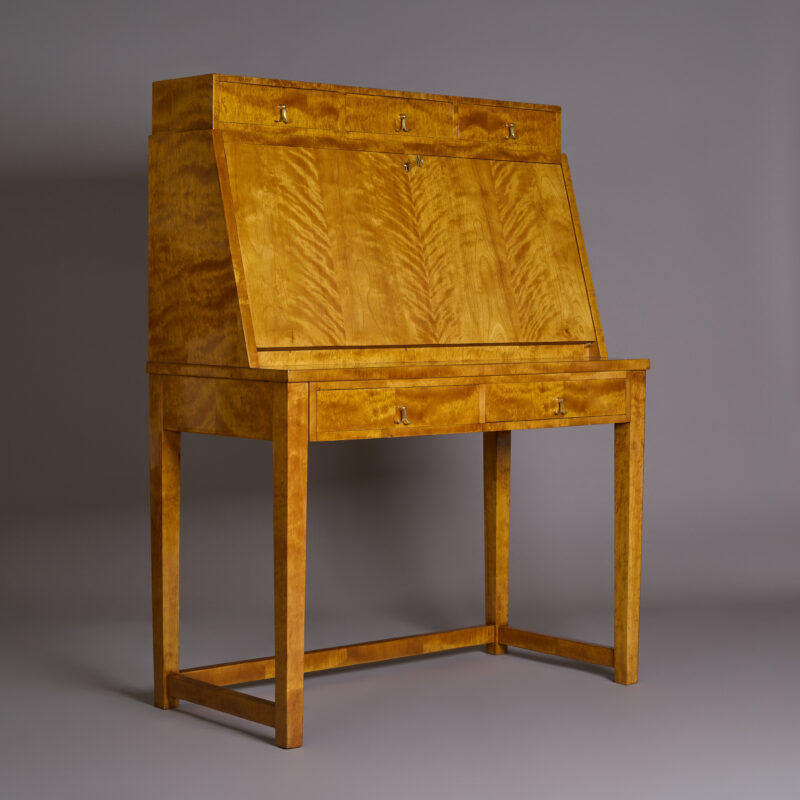
Austrian Writing Desk, 1925/30
Especially beautiful and intricately crafted writing desk from the surroundings or inspired by the designs of the architects of the Austrian Werkbund.
The writing furniture is visually divided into three parts. The lower section is designed in the style of a console table. Here, the four conical, gently sloping legs are connected on three sides with a crossbar and feature two main drawers.
The large main upper section is set back and designed with a slanted large writing flap. When the writing flap is opened, it reveals the beautifully appointed interior. The interior is divided into a wider central segment with two small drawers and two compartments and is bordered on both sides by the smaller segments, each with three compartments. The interior fittings and writing surface are executed in light maple with dark geometric marquetry.
The crowning or concluding element is a slightly set-back upper section executed with three symmetrical drawers.
All hardware is of very fine quality in brass. The handles of the drawers are a design statement of their time in their own right. They are also the only floral element in an otherwise clear design of this furniture.
Stylistically, one could associate these handles with Dagobert Peche.
The entire furniture body is executed with multiple mirrored birch veneers. It comes with a lock and key.
This writing desk also has a matching seat. A cradle-shaped stool with elegantly flared legs and a padded seat, which complements the table perfectly in terms of aesthetics. The seat has been newly upholstered in a light Alcantara.
A beautifully clear design of a writing piece that will become the centerpiece in any modern interior. Additionally, due to its dimensions, this furniture is perfect for smaller spaces, which was also the idea of the designers of that time. Designers such as Josef Frank, Josef Hoffmann, Dagobert Peche, Walter Sobotka, Oskar Strnad, and Oskar Wach, among others, were influential in shaping this era.
Josef Frank and Oskar Wlach was 1925 the founder of the Haus & Garten home furnishing company and furnished among others the interiors of three houses of the Vienna Werkbundsiedlung.
The Austrian Werkbund:
The Austrian Werkbund was founded in 1912 on the lines of the German Werkbund, aiming to ‘ennoble’ the work of product manufacturers by encouraging collaboration between art, crafts, and industry. In its first general assembly in 1913, the underlying concept of the Werkbund was reiterated by its chairman, Baron Adolf Bachofen von Echt: ‘The Werkbund desires to contribute as much as possible to establishing better-quality working practices, to achieving better- or superior-quality products. However, this should include not only expensive, luxury objects […] but also plain, simple and inexpensive wares which can be of superior quality as long as they present themselves honestly for what they are without attempting to pass themselves off as valuable objects’. The newly established association did not want merely to create highly priced objects for a social elite but aspired to ensure that ‘the less well-off, the lower middle and working classes, albeit within very modest limits […] are offered only products that provide joy through their fitness for use and which foster the culture of domestic living’. Among the members of this association of artists, industrialists and craftspeople were Josef Hoffmann, Josef Frank, Oskar Strnad and Dagobert Peche.
Lit: Werkbundsiedlung-Wien.at / Text: Anna Stuhlpfarrer, and
“Photograph of the Guest Room with Secretary in the Krasny House Designed by Josef Frank and Oskar Wlach,” see photo below
Production:
photographer: Julius Scherb, Vienna, after 1928
design of depicted work: Josef Frank, Vienna, 1927 to 1928
design of depicted work: Oskar Wlach, Vienna, 1927 to 1928
execution of depicted work: Haus & Garten, Vienna, 1927 to 1928
stamp (back side): Handwerkliches Lichtbild. / Julius Scherb, Wien, 6. / Gumpendorferstr. 26; Ruf A 30−3−45 /
Mitglied der Wr. Photographenhandwerkstatt
Associated object:
Windsor Armchair, Pultschreibtisch
design: Plan for a secretary (scrutoire) made of matte polished cherrywood, with a detail view of the inside, design: Plan for an upholstered armchair whose armrests are not connected to the backrest, designed for the company Haus & Garten, design: Plan for a firmly upholstered fauteuil with visible wooden frame made of mahogany, used among other things to furnish the Krasny house and the Beer house





